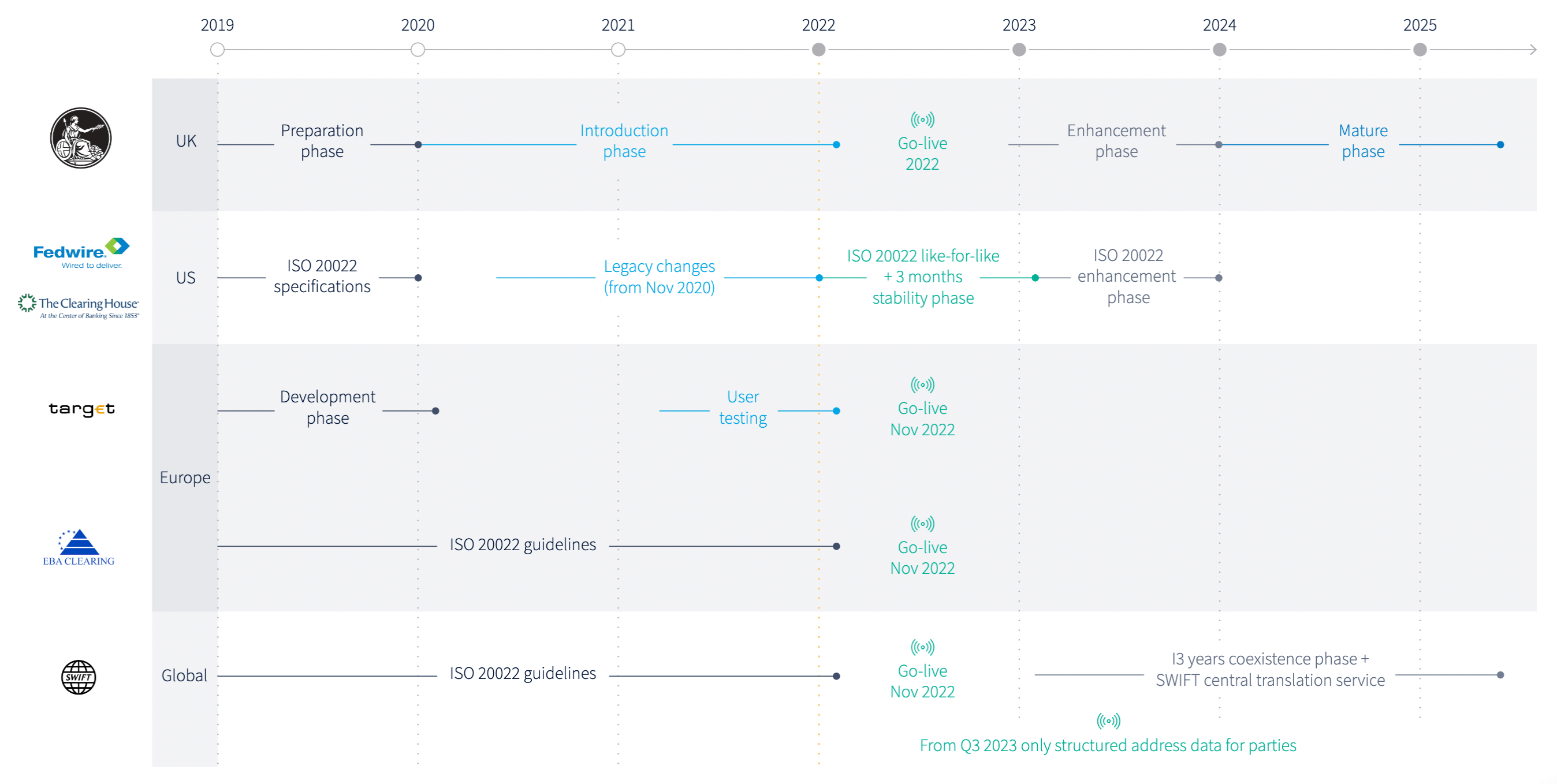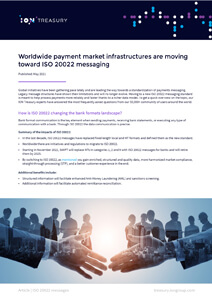ISO 20022: How the new standard impacts financial institutions, corporates, and technology providers
Financial institutions across the globe have started their journey to the ISO 20022 message standard. In some regions, migration has already taken place. But the journey is just beginning for thousands of banks that rely on SWIFT, the global network that connects banks and their customers. The legacy workhorse, the MT format for cash movements and bank statement reporting covering the MT 100, MT 200, and MT 900 messages, is being phased out in favour of the more robust ISO 20022 formats.
ISO 20022 is an international message standard adopted by payment channels across the globe to simplify and improve business communication by eliminating the differences in formats and content that exist amongst systems. The migration to ISO 20022 affects payment initiation and bank reporting differently in each region. By 2025, most financial institutions will have to support the new standard fully.
Challenges of ISO 20022 for financial institutions
As banks transition, they must review how they send and receive messages. For outgoing messages, there are two key challenges:
There are a vast number of payment channels for outbound messages. Each payment channel has a slightly different interpretation of the ISO standard. While there is now a common format, how specific fields need to be populated differs from one locale to another.
At a higher level, banks that process cross-border and high-value payments will have to adhere simultaneously to variations of global standards. Such as the cross-border payment and reporting standard (CBPR+), the high-value payment standard (HVPS+), the regional payment Target 2 (T2) standard in Europe, and RENTAS in Malaysia.
Financial institutions will have to create new transformation libraries for the new common message format to produce outgoing messages that differ from the various formats used worldwide today. In addition to a new structure, the messages contain enriched data elements that may not be captured today. This data must be stored somewhere and sourced in the message generation process.
For inbound messages, financial institutions also face some significant hurdles. Databases and downstream applications like reconciliation engines need to change to accommodate the new data elements in their matching algorithms or simply store the further information arriving in the messages for future use.
Impact of ISO 20022 on corporates
The main burden of the ISO 20022 migration will be on the banks and treasury management system (TMS) providers. Corporates are not mandated to make any changes. However, they should be prepared for the eventual push from banks to use the new formats. By not upgrading, corporates will miss out on the additional information they can provide on payment instructions and the additional details banks will provide on their statements and advice. Corporates can also create some efficiencies by reducing the number of disparate message formats maintained in their translation libraries by deprecating support of the older standards.
To ensure a smooth transition, corporates should:
Anticipate changes to data entry screens and source-system interfaces to accommodate the new data fields.
Modify data validation procedures for newly imported party data and settlement instruction structures to ensure the new data in the ISO formats can be stored in legacy platforms.
Keep an eye on the different migration schedules of ISO 20022, leading to the co-existence of new and old paradigms. For example, Target 2 is migrating in 2022, and SWIFT is migrating gradually through 2025.
Be prepared for changes to the traditional nomenclature. For instance, what was once referred to as “beneficiary” or “payee”, will be called “creditor”. The “payer” or “remitter” will be the “debtor”. During the transition, the terms will need to be used interchangeably.
Although corporate treasurers may be serviced by their TMS provider, they will still need to confirm what is covered. While it is possible in many cases to directly convert from the old format to the new (and vice versa), data will be lost in translation. Treasurers should ensure that they will be given the capabilities to benefit from enriched data.
Importance of migration to ISO 20022
The repercussions of delayed adoption by smaller banks with limited IT resources are unclear from a banking perspective. But, to remain competitive, banks must comply with the ISO changes. Otherwise, they might risk their business declining as they will not be able to receive and deliver statements and payments from other banks on behalf of their customers.
In local markets, smaller financial institutions often lack resources and struggle to adapt to the changes. Here, early adopters may have the opportunity to poach business from competitors.
The migration to ISO 20022 may be complex and time consuming. However, adapting to the new standard will open new opportunities for business process efficiencies, making the migration worthwhile.
Implementation Timeline

ION Treasury’s ISO 20022 plans and project
The ION Treasury team participates in the Common Global Implementation – Market Practice (CGI-MP) initiative. Its goal is to promote wider acceptance of ISO 20022 as the common XML standard used between corporates and banks. In parallel, ION is working aggressively to support its customer’s ISO 20022 adoption plans across its portfolio of treasury management systems. ION’s treasury management experts are updating frequently asked questions and pressing ISO 20022 topics on this related thread.
ION Treasury will be ready to satisfy the banking community’s needs in November 2022 and accommodate those corporates who want to begin their migration as early adopters. Don’t delay! ION’s seven TMS products can help you smoothly transition from yesterday to tomorrow.
![]()

Worldwide payment market infrastructures are moving toward ISO 20022 messaging
To get a quick overview of ISO 20022, our ION Treasury experts have answered the most frequently asked questions from our 50,000+ community of users worldwide.

